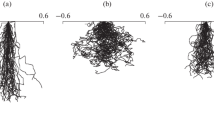Abstract
The prediction of X-ray intensities based on the distribution of electrons throughout solid materials is essential to solve the inverse problem of quantifying the composition of materials in electron probe microanalysis (EPMA) [3]. We present a hyperbolic conservation law for electron transport in solid materials and investigate its validity under conditions typical for EPMA experiments. The conservation law is based on the time-stationary Boltzmann equation for binary electron-atom scattering. We model the energy loss of the electrons with a continuous slowing-down approximation. A first order moment approximation with respect to the angular variable is discussed. We propose to use a minimum entropy closure to derive a system of hyperbolic conservation laws, known as the M1 model [11]. A finite volume scheme for the numerical solution of the resulting equations is presented. Important numerical aspects of the scheme are discussed, such as bounds for the finite propagation speeds, as well as difficulties arising fromspatial discontinuities in thematerial coefficients and the scaling of the characteristic velocities with the stopping power of the electrons.We compare the accuracy and performance of the numerical solution of the hyperbolic conservation law to Monte Carlo simulations. The results indicate a reasonable accuracy of the proposed method and showthat compared to the MonteCarlo simulation the finite volume scheme is computationally less expensive.
Similar content being viewed by others
References
G. F. Bastin and H. J. M. Heijligers. Quantitative electron probe microanalysis of ultra-light elements (boron-oxygen). In: K. F. J. Heinrich and D. E. Newbury (editors), Electron Probe Quantitation, pages 145–161. Plenum Press (1991).
H. Bethe. Zur theorie des durchgangs schneller korpuskularstrahlen durch materie. Ann. Phys., 5 (1930), 325.
D. B. Brown and R. E. Ogilvie. An Electron Transport Model for the Prediction of X-Ray Production and Electron Backscattering in ElectronMicroanalysis. Journal of Applied Physics, 37(12) (1966), 4429.
D. B. Brown, D. B. Wittry and K. D. F. Prediction of X-Ray Production and Electron Scattering in Electron-Probe Analysis Using a Transport Equation. Journal of Applied Physics, 40(4) (1969), 1627.
T. A. Brunner and J. P. Holloway. One-dimensional Riemann solvers and the maximum entropy closure. Journal of Quantitative Spectroscopy & Radiative Transfer, 69 (2001), 543–566.
B. Dubroca and J. Feugeas. Theoretical and numerical study on a moment closure hierarchy for the radiative transfer equation. Comptes Rendus de l’Academie des Sciences Series I Mathematics, 329(10) (1999), 915–920.
R. Duclous, B. Dubroca and M. Frank. A deterministic partial differential equation model for dose calculation in electron radiotherapy. Physics inMedicine and Biology, 55 (2010), 3843–3857.
D. J. Fathers and P. Rez. A Transport Equation Theory of Electron Scattering, pages 193–208. Scanning Electron Microscopy, (1984).
E. T. Jaynes. Gibbs vsBoltzmann entropies. American Journal of Physics, 33 (1965), 391.
D. C. Joy and S. Luo. An empirical stopping power relationship for low-energy electrons. Scanning, 11(4) (1989), 176–180.
E. W. Larsen, M. M. Miften, B. A. Fraass and I. A. D. Bruinvis. Electron dose calculations using the Method of Moments. Medical Physics, 24 (1997), 111–116.
N. Mevenkamp. Inverse Modeling in Electron Probe Microanalysis based on Deterministic Transport Equations. Master’s thesis, RWTH Aachen University (2013).
A. A. Oberai, N. H. Gokhale and G. R. Feijóo. Solution of inverse problems in elasticity imaging using the adjoint method. Inverse Problems, 19(2) (2003), 297.
J. L. Pouchou. X-Ray microanalysis of stratified specimens. Analytica Chimica Acta, 283(1) (1993), 81–97.
J.-L. Pouchou and F. Pichoir. Quantitative analysis of homogeneous or stratified microvolumes applying the model “PAP”. In: K. F. J. Heinrich and D. E. Newbury (Editors), Electron Probe Quantitation, pages 31–75. Plenum Press (1991).
L. Reimer. Scanning Electron Microscopy: Physics of Image Formation and Micro. Springer (1998).
N. W. M. Ritchie. A new monte carlo application for complex sample geometries. Surface and Interface Analysis, 37(11) (2005), 1006–1011.
N. W. M. Ritchie. Spectrum SimulationinDTSA-II. Microscopy andMicroanalysis, 15(5) (2009), 454.
F. Salvat, J. M. Fernández-Varea and J. Sempau. PENELOPE-2006: A Code System for Monte Carlo Simulation of Electron and Photon Transport. In Workshop Proceedings, 4 (2006), page 7.
E. F. Toro. Riemann Solvers and Numerical Methods for Fluid Dynamics: A Practical Introduction. Springer (2009).
Author information
Authors and Affiliations
Corresponding author
About this article
Cite this article
Mevenkamp, N., Pinard, P.T., Richter, S. et al. On a hyperbolic conservation law of electron transport in solid materials for electron probe microanalysis. Bull Braz Math Soc, New Series 47, 575–588 (2016). https://doi.org/10.1007/s00574-016-0170-x
Received:
Published:
Issue Date:
DOI: https://doi.org/10.1007/s00574-016-0170-x
Keywords
- hyperbolic
- conservation law
- method of moments
- entropy closure
- finite volume
- electron transport
- electron probe microanalysis




